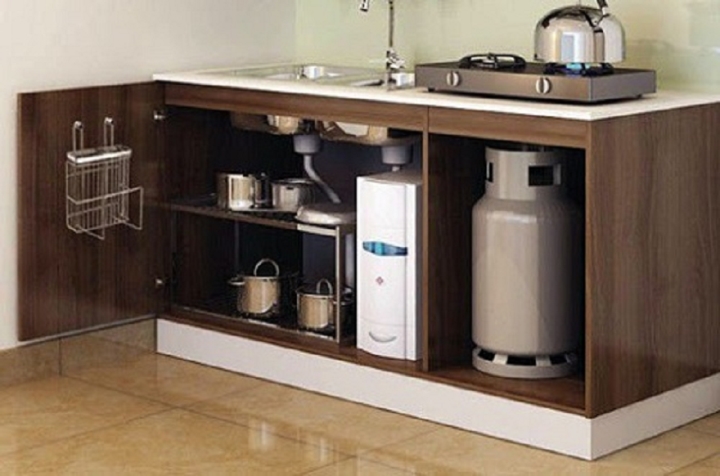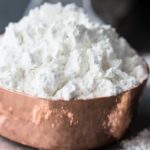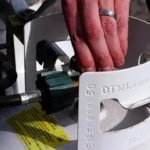Properly placing the gas cylinder will minimize the risk of fire and explosion. To safely place the gas cylinder in the kitchen and enhance its efficiency, you need to consider the following:
Choose a suitable location for placing the gas cylinder
You should place the gas cylinder in a well-ventilated area with good air circulation. The gas cylinder should be lower than the stove and at least 1.5m away to ensure better gas circulation. Additionally, this distance can also be applied to switches, sockets, and electrical devices to limit contact with heat sources and ensure safety for users. Placing the gas stove like this will minimize contact with other heat sources that can affect the gas cylinder, and if placed too close, the risk of explosion will be high.
Place the cylinder in the correct position
Whether the gas cylinder is tall or large compared to the design of the stove, the most important thing to remember is to place the gas cylinder in an upright position. Do not place it on its side or horizontally as it will affect its usage, reduce efficiency, and be very dangerous.
If the gas leaks, placing the cylinder on its side will cause the liquid gas to spill out. Although a small amount of liquid gas will flow out, it will still produce a large amount of gas in the air, which can cause fire and explosion. Furthermore, placing the cylinder on its side will also cause the liquid gas to overflow into the gas pipe, preventing the gas from vaporizing and rising to the stove, causing blockage and affecting the stove’s operation.
By placing the gas cylinder upright in the correct position, if there is a gas leak, the gas will escape at a lower level. In case the kitchen cabinet is designed to be small, it is advisable to place the gas cylinder outside in a well-ventilated area that is convenient for changing the cylinder and ensures safety.

How to properly place the gas cylinder in the kitchen?
Place the gas cylinder in the kitchen cabinet
With a kitchen cabinet design that has grooves or openings for ventilation, you can allocate this space specifically for your gas cylinder to protect it from the heat generated during cooking, corrosion from spices, or any situations that could create an electrical spark.
When placing the gas cylinder in the kitchen cabinet, you should regularly check and ensure that the cylinder is not squeezed or compressed by other tools. The gas hose must be seamless, without any damage or bending, which may affect its usage.
Properly install the gas stove according to safety standards
When starting to install and use a gas stove, users need to check and meet the following basic criteria:
– The location of the stove must be well-ventilated but avoid direct draughts (natural wind or from other devices such as fans).
– The stove must be higher than the gas cylinder.
– The surface where the gas stove is placed should be made of materials such as stone, concrete, glass, etc., and not wood as it is flammable.
– The gas stove should be installed at least 1m away from the ceiling, walls, or other barriers, and at least 15cm away from easily flammable or explosive materials.
– The gas cylinder should be placed in an upright position and lower than the gas stove, placed inside a kitchen cabinet that allows gas circulation (to detect gas leakage immediately). The gas cylinder should also be kept at least 1.5m away from the stove and any electrical sources.
– The gas supply hose should still be in good condition, without any cracks, breaks, or bends during installation. The gas supply pipe must be installed carefully, securely, and tightly with the connections to ensure safety during usage.
– When connecting the gas cylinder to the stove, test turning on the stove to check the flame and turn off the stove properly to check if the valve is sealed.
– When turning on the gas stove, you should first open the valve on the gas cylinder, then open the stove valve to start the gas stove.
– When turning off the stove, you should close the valve on the gas cylinder first, then wait for the flame on the stove to completely go out before locking the stove valve.
Mistakes to avoid when placing and using the gas cylinder
Not locking the gas valve
This is a habit of many people, unintentionally causing dangers during usage. At this time, there is still residual gas in the supply hose, which can cause leaks and, if exposed to an electrical spark, can lead to an explosion.
Therefore, to protect yourself, you should lock the gas valve after usage. This is also an effective way to save gas.
In addition, you should not spray insecticides near the gas cylinder or near the gas stove that is in use to avoid explosions or spreading fires.
Using too old gas cylinders
When using very old gas cylinders, it is easy to encounter situations where the cylinder is dented or the cylinder’s casing is no longer reliable, which can cause dangerous situations. The credibility of the gas supplier and the quality of the gas they provide will greatly affect your usage needs. Therefore, you should choose gas from reputable dealers, with new gas cylinders that meet the usage standards and have appropriate prices.
Not regularly checking the hose and valve
Almost all large gas cylinders nowadays are equipped with safety devices, so the occurrence of explosions is rare because these safety devices will cut off the gas supply, preventing the gas from entering the hose.
Regularly checking the hose and valve will help you avoid gas leaks, prevent fires and explosions, and save gas in your household. If you detect a gas leak, immediately shut off the gas cylinder, avoid turning on any switches or devices that generate sparks to prevent fires and explosions.
Source: vtc.vn
Dangers of Using Water to Extinguish a Grease Fire
Cooking safely is essential for the wellbeing of everyone in the household. It is important to be mindful of the potential for kitchen mishaps while preparing meals, such as the risk of pots or pans catching fire. To avoid any harm, the following safety measures should be taken into account while cooking.



































